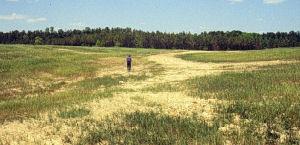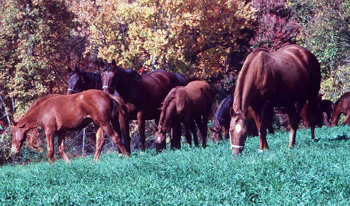Proper pasture management is important to holistic farm management. Grazing animals deposit manure on pastures and exercise areas. This manure ultimately will either be incorporated into the pasture soil or if the pasture is poorly vegetated it may be a runoff risk. So, the first principle of managing manure with grazing animals is to ensure productive pastures. Productive pastures will reduce the risks of manure runoff by providing ground cover that will prevent soil erosion. These pastures will also take up nutrients from manure and use them for crop growth. Less productive pastures will not do this. ( ABC’s of Pasture Grazing) ( Spanish Language Version)
What Makes a Pasture Productive?
What are some elements of productive pasture management? Proper soil health and fertility will ensure a good growth environment for pasture species, both forage and legume. Manure can help to improve and maintain soil fertility by providing needed nutrients, (N, P, and K) and organic matter. These nutrients will help promote growth of grasses and legumes while organic matter from manure will help to provide soil structure, protection against erosion and improve natural soil fertility. Choosing the appropriate grass and legume species will help optimize forage management and pasture growth. (see More Equine Pasture Management Materials)
Pasture rotation is also practiced in order to optimize plant growth and utilization by grazing vegetation at the proper heights and allowing for proper rest and regrowth. Activities such as brush hogging or clipping, dragging to break up manure clumps, fertilizing and over seeding are also necessary components of pasture forage management.
Sacrifice Areas
Exercise or sacrifice areas are designated locations for feeding, watering, exercise and relaxation for times when pastures are not accessible due to lack of growth (winter or drought), flooding, etc. (see Exercise or Sacrifice Lots for Horses) Generally, these areas have little or no vegetation. It is important that manure not be spread in these areas. They are meant to be sacrificed for animal activities in order to protect the remaining pastures. Runoff from sacrifice areas should also be managed to reduce the risk of water pollution caused by sediment and nutrients from these areas.
Erosion
Erosion is a problem for several reasons. First, nutrients attach to soil particles. When they wash away, the Phosphorus causes algae blooms in freshwater. When that algae dies, oxygen in the water adheres to it, producing a lack of oxygen in the water for fish and other aquatic life. The sediment from erosion also covers nesting habitat for aquatic life and reduces visibility for desirable sport fish like walleye. Lastly, the runoff can contain bacteria from the manure that can be harmful to people downstream.
Erosion problems on small farms are often different than large farms. On large farms, most erosion may be sheet or rill erosion running off large fields. On smaller farms, erosion may more often be a gully where animals cross a stream. Or it could be poorly vegetated pastures that provide poor ground cover during precipitation. Fencing, watering and feeding sites, presence or absence of field buffers, and stream crossings can all influence erosion on a small livestock farm.

This pasture management section provides information about proper pasture management in order to reduce water quality, manure runoff and soil erosion risks that may be associated with poor pastures. The following links provide more specific information:
More on Horse Manure Management
- Equine Barnyard Management
- Exercise or Sacrifice Lots for Horses
- Fencing To Limit Horses Access to Riparian Areas
- Horse Manure Management
- Live from the National Water Quality Meetings
- Manure Storage on Horse Farms
- Off-Farm Manure Disposal
- Pasture Management on Horse Farms
- Spreading Manure on Horse Farms
- Stall Waste Production and Management
Author: Michael Westendorf, Rutgers, The State University of New Jersey


